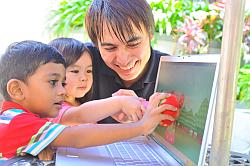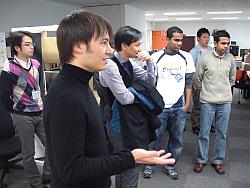 We are very very please here to present you Pr Adrian David Cheok, Professor at Keio University (Japan) and a famous expert on mixed and augmented reality. Linked to Augmented Reality Summit 2013 in Mumbay, he kindly respond to few of our questions.
We are very very please here to present you Pr Adrian David Cheok, Professor at Keio University (Japan) and a famous expert on mixed and augmented reality. Linked to Augmented Reality Summit 2013 in Mumbay, he kindly respond to few of our questions.
Could you please explain in a few words what is mixed reality in relation with augmented reality ?
Mixed reality (the fusion of augmented and virtual reality) is a technology that allows the digital world to be extended into the user’s physical world. Unlike virtual reality in which the user is immersed in an artificial world, mixed reality operates in the user’s real world. Mixed reality is the transition between real world to virtual world, with augmented reality and augmented virtuality being part of the mixed reality spectrum. Mixed reality can be used to develop an almost magical environment where the virtual world, such as 3D computer graphics images and animations are merged with the real world as seamlessly as possible in real time. For example architects could work on a realistic virtual 3D model on their desk, and then enter the model together to explore the inside of the virtual buildings, surgeons could “see” the inside of a patients body before operating, children could see animals from exotic lands, and play with them in their real physical space, people could play games with each other together with virtual characters or creatures that appear in their real environment. In the military there are vast applications of mixed reality in battlefield visualization, simulation, and training, soldier information systems, maintenance, and security.  Hence mixed reality is can become a highly important component of future computing systems. It will allow humans to interact with each other in ways that now can only be imagined, and will allow humans to interact with computers in a way that goes beyond the desktop computers we have now. Mixed reality allows tangible interaction with 3D virtual objects. For example by moving a physical object, or marker, one can move and interact with virtual objects as if they were real objects in our physical world. Thus, a true tangible interaction between the physical and digital world is achieved.
Hence mixed reality is can become a highly important component of future computing systems. It will allow humans to interact with each other in ways that now can only be imagined, and will allow humans to interact with computers in a way that goes beyond the desktop computers we have now. Mixed reality allows tangible interaction with 3D virtual objects. For example by moving a physical object, or marker, one can move and interact with virtual objects as if they were real objects in our physical world. Thus, a true tangible interaction between the physical and digital world is achieved.
How is the AR market in Asia? What the biggest usage of this technology ?
The leader in usage of AR seems to be Japan currently, I think because the proliferation of QR codes had made adding AR content easier, but other Asia Pacific countries are fast becoming active users. The biggest use is for computer games, advertising, and location based social information.
In your opinion, what is the place of this mixed reality and Augmented reality in our world in 2030 ?
I am currently working on research into the next steps of mixed reality which will go beyond audio/visual augmented reality into a mixed reality for all the five senses. In traditional human communications, body gestures and touch can sometimes more deeply explain the intended mind and provide intrinsic information, which makes for a more rich communication exchange. Furthermore, we often communicate emotionally using all the senses simultaneously, including sight, touch, sound, but also through taste and smell, such as sharing a meal together or cooking for a partner. We thus need to create fundamentally new forms of media to connect humans in the physical world and through the virtual world co-space, not just in the transmission of information and verbal communication, but through meaning and nonverbal communication to increase the sense of telepresence using all the senses.  We can use new technologies related to multimodal sensing and actuation to give the user more definition in their experience in augmented environments. Visual, Auditory, Haptic, (Olfactory) Smell, and (Gustatory) Taste are the five sensors that humans use for environmental sensing, and emotional feeling communication. In addition to traditional communication through telephone and videoconferencing, the use of haptics, smell, and taste communication will enable a new paradigm of mixed reality communication. I’m currently working on my lab on research which proposes novel ways of communicating feelings emotions through chemoreceptive media by creating real-time, complex sensing and actuation of smell and taste. In 2030 I believe mixed reality will extend to all of our senses. For example not only could you see a virtual friend in your living room, but touch and feel them them, and enjoy a dinner date with them enjoying the smell and taste of virtual food.
We can use new technologies related to multimodal sensing and actuation to give the user more definition in their experience in augmented environments. Visual, Auditory, Haptic, (Olfactory) Smell, and (Gustatory) Taste are the five sensors that humans use for environmental sensing, and emotional feeling communication. In addition to traditional communication through telephone and videoconferencing, the use of haptics, smell, and taste communication will enable a new paradigm of mixed reality communication. I’m currently working on my lab on research which proposes novel ways of communicating feelings emotions through chemoreceptive media by creating real-time, complex sensing and actuation of smell and taste. In 2030 I believe mixed reality will extend to all of our senses. For example not only could you see a virtual friend in your living room, but touch and feel them them, and enjoy a dinner date with them enjoying the smell and taste of virtual food.
Grégory MAUBON est consultant indépendant en réalité augmentée (animateur et conférencier) depuis 2008, où il a créé www.augmented-reality.fr et fondé en 2010 RA'pro (l'association francophone de promotion de la réalité augmentée). Il a aidé de nombreuses entreprises (dans plusieurs domaines) à définir précisément leurs besoins en réalité augmentée et les a accompagnées dans la mise en œuvre.


Très bonne, idée, j’ai trouvé très utile sure tout pour le couple soit avant le mariage ou après, et avec ça, la réalité augmenté participe avec la réalité virtuelle de sauvegarder les relations humaines, et en fin de compte, l’innovation et les sciences restent toujours au services de l’Être humain.
à mon avis, la réalité Mixte, remplacerai les deux autres type de réalité pour les applications qui ont de relation avec tous ce qui a en relation avec les relations humains.
en attendant autre application basant sur ce type de technique.